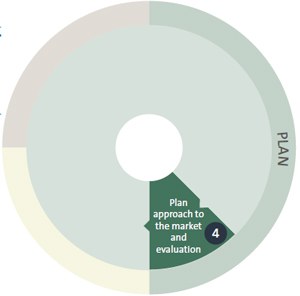Part 6: Planning an approach to the market and evaluation
 6.1
6.1
The fourth stage in the procurement life cycle is planning how the procurement will be carried out and justifying these decisions. This is sometimes called the procurement approach.
6.2
There are various options for approaching the market, depending on the nature and complexity of the service, the value and length of the contract, and the size of the market or supplier community.15
Planning the procurement approach
6.3
Planning the procurement approach is necessary to identify the best way to approach the procurement for the goods and services in question, and to identify risks and ways of achieving the procurement objectives.
6.4
How much detail is needed in planning the procurement approach will depend on the value and risk associated with a particular procurement. It can include project scope, the procurement method, whether the approach will be open or closed or multi-staged, how the public organisation will work with the market, and the form of contract. Planning the approach should also include selecting the evaluation model (including evaluation criteria) and process.
6.5
Our audit work has shown that public organisations are increasingly using a range of collaborative procurement approaches to deliver important infrastructure and other large-scale projects. These include open competitive processes, working with suppliers to develop solutions, or partnerships where the risks are shared. One such approach has been public private partnerships, which have been used in a number of sectors in recent years.
6.6
As well as giving full consideration to the principles and good practice guidance and rules, public sector procurement also has to work sensibly for suppliers. There need to be robust processes that will work well in a collaborative environment for an innovative and fast-moving public sector, and when there is urgency about a procurement.
Our proposed audit work
6.7
We will continue to consider through our audit work how public organisations plan procurements to ensure that they are done in a principled way, and use practices that work for suppliers and are responsive to the needs of an innovative and fast-moving public sector.
6.8
At this stage, we have chosen to look at public private partnerships because local councils and central government have used public private partnerships to fund and build major infrastructure projects. We have a long-standing interest in their use and have published reports on public private partnerships in 2006 and 2011.16
| We intend to examine how collaborative arrangements have been established and managed for best effect, and provide assurance that the expected benefits are well defined, monitored, and assessed. Because there have been a number of public private partnerships set up already in the transport, education, and justice sectors, we propose in the first instance to explore how effectively these public private partnerships are delivering on their intended outcomes. We intend to identify lessons from these examples that might be applicable to various forms of collaborative contracting that involve a large amount of public expenditure. |
15: New Zealand Government Procurement, Guide to procurement at procurement.govt.nz.
16: Office of the Auditor-General (2011), Managing the implications of public private partnerships and (2006), Achieving public sector outcomes with private sector partners.

